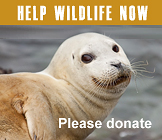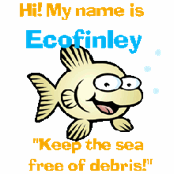May 2017
Feeding sea lions and seals is illegal, harmful and dangerous
May/22/17 06:43 PM
The recent British Columbia incident where a California sea lion yanked a young girl off a commercial dock and into the Strait of Georgia has made international headlines. People had been feeding the sea lion bread (most decidedly not a sea lion staple food) minutes before the child’s clothing was grabbed; this, despite numerous signs clearly warning that feeding marine mammals was not permitted. The child, who had been perched on the edge of the pier at Steveston Fisherman’s Wharf, was quickly rescued from the water and did not appear to be injured.
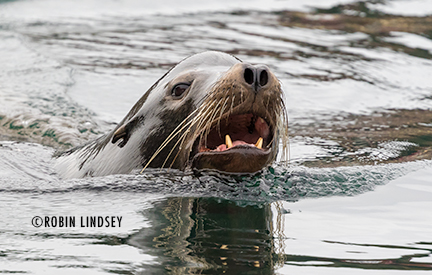 Sea lions are curious, gregarious, lively, loud and large (up to 1000 lbs). It goes without saying that they are wild animals and, as such, are unpredictable in their behavior. The blame for this unfortunate occurrence in Canada does not lie with the sea lion, who likely mistook the child’s light-colored dress for fish.
Sea lions are curious, gregarious, lively, loud and large (up to 1000 lbs). It goes without saying that they are wild animals and, as such, are unpredictable in their behavior. The blame for this unfortunate occurrence in Canada does not lie with the sea lion, who likely mistook the child’s light-colored dress for fish.
The high-profile story has raised public awareness about the hazards this type of feeding interaction poses to humans, but the dangers to marine mammals must not be overlooked.
It is illegal to feed marine mammals in the wild, both in Canadian and United States waters. Marine mammals are protected by U.S. Federal law, Marine Mammal Protection Act, from harm by humans. If you feed or attempt to feed a marine mammal in the wild you put yourself and the animal at risk of injury and may be investigated by NOAA’s Office for Law Enforcement (OLE) for marine mammal harassment.
There are many potential consequences to feeding wild animals. Altering a seal or sea lion’s behavior can prove harmful by interfering with their ability to hunt and feed. If conditioned to approach people and vessels for food, they are at increased risk of injury and death. Marine mammals are wild animals that normally feed on live fish that they hunt and catch on their own.
Feeding marine mammals can cause them to lose their natural wariness of humans or boats and condition them to beg for handouts instead of foraging for their normal prey. They can become sick if they eat food that is spoiled or food that is not part of their normal diet, or they can get injured if they are too close to boats. They may also begin taking bait and catch from fishing gear, risking injury or death by entanglement in or ingestion of fishing gear.
There have been cases of people being bitten by dolphins and sea lions that become aggressive while begging for food, being teased with food by people, or expecting a handout.
Help keep marine mammals safe - and wild. If you observe someone feeding a seal or sea lion, please call OLE’s national hotline at 1-800-853-1964 (information may be left anonymously).
UPDATE 5/28/17
At the urging of marine mammal specialists in media posts, the family was encouraged to seek medical treatment - and did - for mild abrasions suffered in the incident, as bacteria and disease can be transmitted by contact with marine mammals.

The high-profile story has raised public awareness about the hazards this type of feeding interaction poses to humans, but the dangers to marine mammals must not be overlooked.
It is illegal to feed marine mammals in the wild, both in Canadian and United States waters. Marine mammals are protected by U.S. Federal law, Marine Mammal Protection Act, from harm by humans. If you feed or attempt to feed a marine mammal in the wild you put yourself and the animal at risk of injury and may be investigated by NOAA’s Office for Law Enforcement (OLE) for marine mammal harassment.
There are many potential consequences to feeding wild animals. Altering a seal or sea lion’s behavior can prove harmful by interfering with their ability to hunt and feed. If conditioned to approach people and vessels for food, they are at increased risk of injury and death. Marine mammals are wild animals that normally feed on live fish that they hunt and catch on their own.
Feeding marine mammals can cause them to lose their natural wariness of humans or boats and condition them to beg for handouts instead of foraging for their normal prey. They can become sick if they eat food that is spoiled or food that is not part of their normal diet, or they can get injured if they are too close to boats. They may also begin taking bait and catch from fishing gear, risking injury or death by entanglement in or ingestion of fishing gear.
There have been cases of people being bitten by dolphins and sea lions that become aggressive while begging for food, being teased with food by people, or expecting a handout.
Help keep marine mammals safe - and wild. If you observe someone feeding a seal or sea lion, please call OLE’s national hotline at 1-800-853-1964 (information may be left anonymously).
UPDATE 5/28/17
At the urging of marine mammal specialists in media posts, the family was encouraged to seek medical treatment - and did - for mild abrasions suffered in the incident, as bacteria and disease can be transmitted by contact with marine mammals.
Harbor porpoise necropsied today
May/17/17 06:57 AM
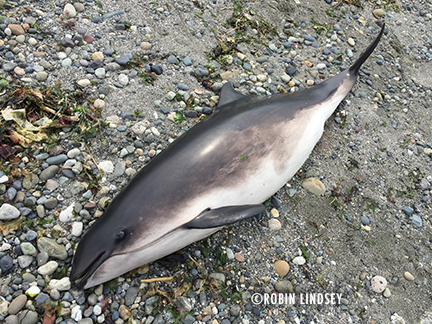
Brand new Seal Sitters (SSMMSN) volunteer Judy, trained this past Saturday, was out for a hike near West Seattle’s lighthouse yesterday afternoon when she came across a fresh-dead harbor porpoise on the pebbled beach. Having just learned that SSMMSN responds to reports of all marine mammals, dead and alive, she contacted the proper authorities and SS First Responder Lynn arrived on scene, shortly after our hotline @ 206-905-SEAL (7325) received the report.
Cascadia Research Collective was immediately called and confirmed they wanted the porpoise for necropsy. First Responders Robin, David and Ralph arrived and photos were texted to Jessie Huggins, stranding coordinator for Cascadia. Based on initial review of photos sent by Seal Sitters, it appears the adult female is either pregnant or recently gave birth. Plans were set in motion for biologist Erin Keene and a former intern to drive a truck up from Tacoma to collect the perfect specimen.
With the help of several members of the public (also environmental stewards), the approximately 125-150 lb porpoise was rolled onto a tarp, carried off the beach and up into a private driveway, where she was picked up by the Cascadia team shortly after 6pm. Thanks so much to homeowner Margaret who allowed us access thru her property, making the transfer off the beach much shorter and kudos to those who helped carry the heavy porpoise.
The stunning porpoise showed no obvious injuries, aside from nicks on flippers. Possible predation by transient orcas is always a concern, especially with the recent heightened transient presence in Central and South Puget Sound, and internal hemorrhaging from such an attack could still be present (often times, prey is rammed and not consumed). However, it seemed more likely that cause of death was related to pregnancy complications or disease.
In the Pacific Northwest’s Salish Sea, harbor porpoise calving typically occurs in the summer months. On May 1, 2013, SSMMSN responded to a dead neonate on the shoreline along Beach Drive. Harbor porpoise numbers have greatly rebounded in Puget Sound, after nearly disappearing in the 1970s. Cascadia and WDFW Marine Mammal Investigations collaborated on a study of 20 year aerial surveys of Washington waters. Read more about the species’ return in this recent paper. An additional resource can be viewed here on NOAA’s website.
NECROPSY RESULTS
The necropsy was performed by Cascadia today. The female was indeed pregnant, but probably a month or two away from full term. There was no trauma or evidence of pregnancy complications, but an underlying disease that may have caused early termination of pregnancy can’t be ruled out. Neurological disease is suspected and will be further evaluated histologically. A moderate lungworm infection was found, which is fairly typical for this particular species, but can also be a symptom of a more significant disease process.
Tired, but sneaky little weaner seal seeks resting spot
May/11/17 10:46 AM

It’s a real challenge for wildlife to find quiet, safe places to rest undisturbed along the shoreline of urban areas. Monday morning was no exception. Very early, the hotline received a call about another weaner seal on the beach, just south of the West Seattle Water Taxi. Arriving within minutes, Seal Sitters first responder found a very wet little seal taking a power nap on the pebbled shore. Tape was stretched between cones and sandwich boards to establish a smaller-than-normal buffer zone around him since the beach was just below the sidewalk.
Having barely finished taping off the area and grabbing a couple of quick identification photos, the increasing bustle of ferry commuters convinced the weaned and estimated 9-month old seal to return to the blue-gray waters of Elliott Bay. Gathering up materials, responders discussed that this was not Seafoam or another weaner we recognized.
No sooner had stranding materials been stashed back in the car, the hotline received a second call - of a seal pup perched a stone’s throw away, around the corner on the rocks just below the fishing pier and ramp down to the Water Taxi (two views of same weaned pup above). Cones and tape were stretched again to keep people from standing right above him. Within about half an hour, however, with a receding tide and a steady stream of commuters who walked close-by, down the ramp to catch the boat and head into downtown Seattle, the weaner slipped off the jagged boulder and into the water. It was unanimous that the perfect nickname for the seal was little Rascal.
Responders removed the materials and observed Rascal for some time, lingering offshore in the tiny cove - a good fishing hole, ripe for foraging.
Volunteers spend long hours protecting Seafoam
May/10/17 07:33 AM
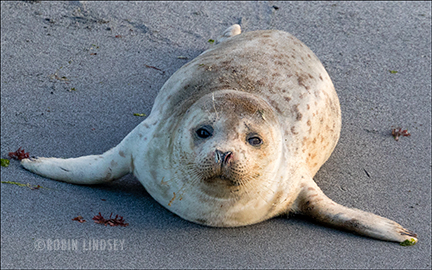
On Friday afternoon, First Responders David and Eilene were out for a walk along West Seattle’s Alki Trail and noticed a group of bystanders gathered on the seawall above a small pocket beach and common spot for seal pups to come ashore. Thankfully, barricades and tape were stashed at the site. They quickly asked the crowd to step back and cordoned off the small area. Volunteers were summoned and the pup was able to rest on the beach until very late that night, gone shortly after midnight.
This weaner, nicknamed Seafoam, looked quite typical for the majority of seals born last year and now almost a year old: thin and with some respiratory issues (nasal and eye discharge and some coughing), after surviving a very long, wet and cold winter. The good news is that a milder spring brings a more bountiful food source to Puget Sound and lungworm infections, if not too serious an infestation, can sometimes wane.
These older weaners will soon be molting, afterwards sporting a brand new, silky coat. These days, the coats become brownish, scruffy and lackluster in the pre-molt and then it’s out with the old, gradually filled in with new shiny fur and well-defined markings. Weaners/yearlings are the first seals to molt. Adults in Central and South Puget Sound do so after breeding in the summer and early fall. Fur does not provide warmth for harbor seals, who instead depend on a thick layer of blubber fat for insulation energy.
Early Saturday morning, Seafoam crawled onshore again, but this time further east, around the bend on a little strip of beach in Elliott Bay. Staying until high tide erased the beach and water rushed over him, the seal took off and headed north. Gathering up cones and tape, volunteers walked along the seawall, following Seafoam as he traversed back to his prior evening’s resting spot.
Once again, volunteers taped of the grassy landing above the seal and closed access to the beach steps. Families, joggers, bikers and walkers all paused to talk to volunteers and get a great, close-up view of the sleepy seal, trying to snooze in the midst of a noisy whirl of urban activity. Many inquired if it was seal pup Taffy, now in rehab at PAWS Wildlife Center. Seafoam rested until 8:30pm before returning to the dark waters of the Sound.
Around 8am Sunday, the hotline received a report of a pup on the west side, below Alki Avenue’s sea wall. When First Responder Robin arrived she could see the seal’s tracks in the sand, leading from the seawall to the lapping water’s edge - and human footprints leading up to and across to the resting site. There was no seal and no person. She stopped a young couple walking by and asked if they had seen the seal. They stated that a woman had been down on the beach, too close to the seal and taking cell phone photos. Despite their warnings that she needed to stay back, she scared him back into the water.
Seafoam showed up less than an hour later on the opposite side of the point, with a repeat performance of the day before: sleeping at the Elliott Bay location until high tide and then swimming back to his second preferred location at Duwamish Head. Because it was a beautiful day, there were people on the pocket beach, but they graciously vacated the area to allow the determined little seal with the big, soulful eyes some additional rest.
Volunteers protected Seafoam until after 9pm, when he finally flip-flopped across a very long stretch of sand and disappeared into the Sound. He has not been sighted since.
Thanks to the first responders and dedicated volunteers who spent three long days - and windy and cold evenings - looking after Seafoam. They spoke with hundreds of people who stopped by the two locations to ooh and ahh and learn about seal behavior and biology and the many struggles that weaner seals face their first year of life.

